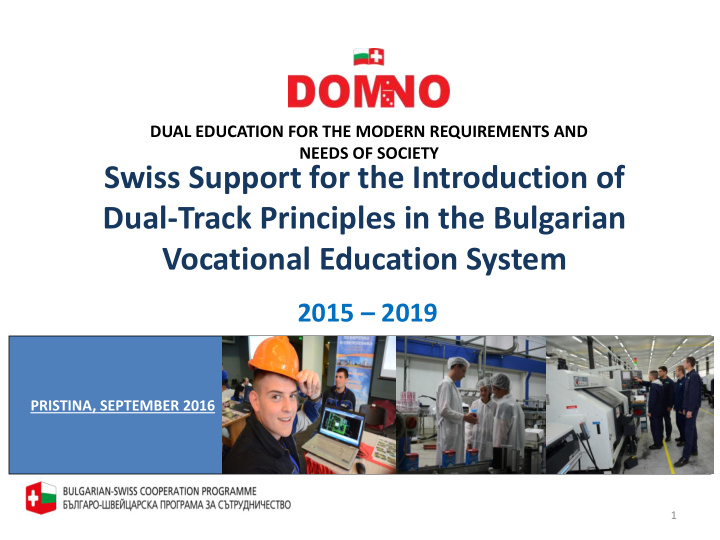



DUAL EDUCATION FOR THE MODERN REQUIREMENTS AND NEEDS OF SOCIETY Swiss Support for the Introduction of Dual-Track Principles in the Bulgarian Vocational Education System 2015 – 2019 PRISTINA, SEPTEMBER 2016 1
National Statistics Bulgaria in figures Institute April 2016 Population 7 153 784 Employment rate (20-64 y) 68.1 % Unemployment rate (20-64 y) 7.9 % Youth unemployment (15-29 y) 14.5 % Youth unemployment (15-24 y) 22 % Students in secondary general education 129 354 schools Students in vocational schools 135 578 VET Schools (8/9-12 grade) 423 Male/Female VET students 60 % / 40 % VET Professions 239 2
MAIN OBJECTIVE CREATE A REPLICABLE MODEL AND BUILD CAPACITY FOR IMPLEMENTING DUAL VET IN BULGARIA BUDGET CHF 3,500,000 AIMED RESULTS 10 PROFESSIONS 15 SCHOOLS 1200 STUDENTS 3
STATE INSTITUTIONS INVOLVED Swiss Agency for Development and Cooperation (SDC) National Coordination Unit Ministry of Education and Science Ministry of Labour and Social Policy Ministry of Economy National Agency for Vocational Education and Training PMU embedded in MES 4
IMPLEMENTATION OF THE MODEL grade 9th 10th 11th 12th 1.0 1.0 3.0 4.0 Days per Week 3.0 3.0 1.0 1.0 1.0 1.0 1.0 General Education 4.0 3.0 1.0 1.0 45.0% In-Company-Training 0.0 1.0 3.0 3.0 35.0% Professional Theory 1.0 1.0 1.0 1.0 20.0% 5
THE APPROACH DEVELOP SITUATION PROFILES WITH PROFESSIONALS USING THE SWISS MODEL DEVELOP QUALIFICATION PROFILES CURRICULA AND SYLLABI DEVELOPMENT 6
CNC MACHINES EXAMPLE OF A SITUATION Professional Competence Area Manufacturing parts Situation Title Manufacturing parts with conventional machines Example of a Situation: Todor has been assigned to manufacture a rotation part using a conventional lathe. He receives the technical documentation and the rotation workpiece. He studies the technical documentation and prepares the necessary tools. He adjusts the work mode on the lathe (revolutions, cutting/feeding depth). He puts the protective goggles on and mounts the turning steel into the turning-steel-holder. He sets the turning machine in motion and centres the turning steel. He starts processing the front surfaces and proceeds with longitudinal turning. After turning the lathe off, he measures the dimensions obtained to assess if they meet the requirements in the drawing. Knowledge required - knows how to use and interpret technical documentation - is familiar with the tolerance system - is familiar with the structure and mechanism of action of the lathe, the universal milling machine - is familiar with the type and purpose of cutting tools used on a universal lathe, universal milling machine, drilling machines - is familiar with the structure and application of measuring instruments Skills required - applies occupational safety and health regulations - applies technical documentation - is able to adjust a universal lathe - maintains the parameters of the lathe knife and milling tools - is able to use measuring instruments Social competencies required - follows the rules - works autonomously - work well in a team - works efficiently - works accurately/precisely - facilitates communication 7
WORK WITH SWISS FEDERAL INSTITUTE FOR VOCATIONAL EDUCATION AND TRAINING (SFIVET) WORKSHOPS FOR DEVELOPING QUALIFICATION PROFILES MONITORING VISITS TEACHERS TRAININGS INSTRUCTORS TRAININGS DTE TRAININGS 8
WORK WITH VET STAKEHOLDERS VET FOR VET FORUM UM AIM SESSIONS PARTICIPANTS DECISIONS 9
PROFESSIONS year PROFESSION 1 2015 MACHINE TECHNICIAN 2 2015 DAIRY PRODUCTION TECHNOLOGIST 3 2016 ELECTRICAL TECHNICIAN 4 2016 GAS TECHNICIAN 5 2016 COOK *2017 6 Automotive Mechatronics 7 Industrial Electronics 10 8 Furniture Production
GEOGRAPHICAL SCOPE 11
WORK WITH BUSINESS VET FORUM VISITS AND MEETINGS REGIONAL INFORMATION DAYS INFORMATION EVENTS ORGANIZED BY LOCAL OR BRANCH CHAMBERS 12
WORK WITH STUDENTS, PARENTS AND TEACHERS STUDENTS/PARENTS/TEACHERS MEETINGS MEDIA, PROMOTIONAL MATERIALS INCENTIVES FOR STUDENTS/SCHOLARSHIPS 13
COMMUNICATION AND VISIBILITY information events in different cities interviews, tv and media coverage, articles project name, project logo Facebook page 14
2015 progress in numbers PROFESSIONS 2 SCHOOLS INVOLVED 2 CLASSES STARTED DUAL EDUCATION 4 STUDENTS INVOLVED 81 PARTNER COMPANIES INVOLVED 5 VET TEACHERS TRAINED 13 INSTRUCTORS TRAINED 11 DVET EXPERTS TRAINED 9 15
RISKS AND CHALLENGES • political commitment • lack of confidence between schools and companies • parents ’, students’ and teachers’ concerns • unknown system for the BG business 16
POTENTIALS reform the BG VET system using the Swiss model create a replicable model use EU Structural Funds (2015-2020) enhance students’ skills and competences 17
LESSONS LEARNED • ONE COUNTRY’S SYSTEM CANNOT BE COPY/PASTED IN ANOTHER COUNTRY – A NEW MODEL HAS TO BE FOUND APPLICABLE IN LOCAL ENVIRONMENT USING BEST PRACTICES • EXPERTS WITH EXPERIENCE IN FOREIGN ENVIRONMENT SHOULD BE ATTRACTED 18
CONTACTS PROJECT MANAGEMENT TEAM Ms. Petya Evtimova Team Leader p.evtimova@mon.bg +359 2 9217 520 Ms . Polina Zlatarska Mr. Nikolay Georgiev Business Services Expert VET Expert p.zlatarska@mon.bg n.georgiev@mon.bg +359 2 9217 791 +359 2 9217 614 /swissdualeducationbulgaria
Recommend
More recommend